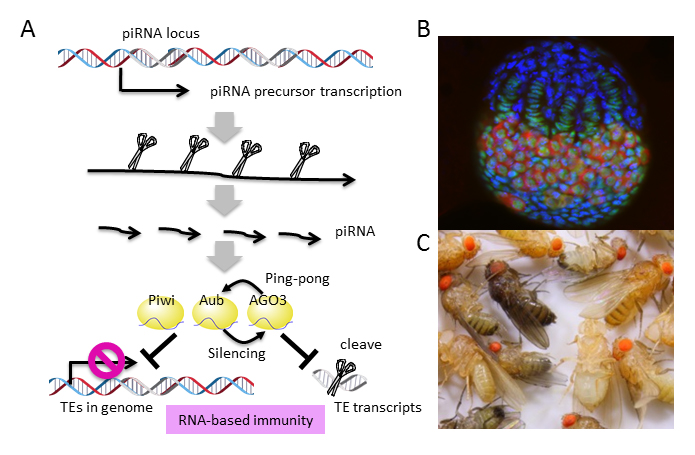Saito Group • Invertebrate Genetics Laboratory
Mechanisms and biological significance of RNA-mediated gene regulation in Drosophila
Faculty
▶ Lab HP
Research Summary
RNA acts as not only a carrier of genetic information but also a highly versatile molecule that can be cut, connected, and dramatically change its steric structure. Our laboratory is studying molecular mechanisms and physiological functions of RNA-based gene regulation in Drosophila. To understand them, we are engaged in investigating the piRNA pathways, RNA modifications (epitranscriptome) and germ line development using biochemical and high-throughput technologies, and genetic tools which are managed and distributed by genetic resources project (NIG-Fly).

Selected Publications
Utsuno Y, Hamada K, Hamanaka K, Miyoshi K, Tsuchimoto K, Sunada S, Itai T, Sakamoto M, Tsuchida N, Uchiyama Y, Koshimizu E, Fujita A, Miyatake S, Misawa K, Mizuguchi T, Kato Y, Saito K, Ogata K, Matsumoto N. Novel missense variants cause intermediate phenotypes in the phenotypic spectrum of SLC5A6-related disorders. J Hum Genet. 2024 Feb;69(2):69-77.
Takeuchi C, Yokoshi M, Kondo S, Shibuya A, Saito K, Fukaya T, Siomi H, Iwasaki YW. Mod(mdg4) variants repress telomeric retrotransposon HeT-A by blocking subtelomeric enhancers. Nucleic Acids Res. 2022 Nov 11;50(20):11580-11599.
Yamamoto-Matsuda H, Miyoshi K, Moritoh M, Yoshitane H, Fukada Y, Saito K, Yamanaka S, Siomi MC. Lint-O cooperates with L(3)mbt in target gene suppression to maintain homeostasis in fly ovary and brain. EMBO Rep. 2022 Oct 6;23(10):e53813.
Nagata R, Akai N, Kondo S, Saito K, Ohsawa S, Igaki T. Yorkie drives supercompetition by non-autonomous induction of autophagy via bantam microRNA in Drosophila. Curr Biol. 2022 Mar 14;32(5):1064-1076.e4.

















